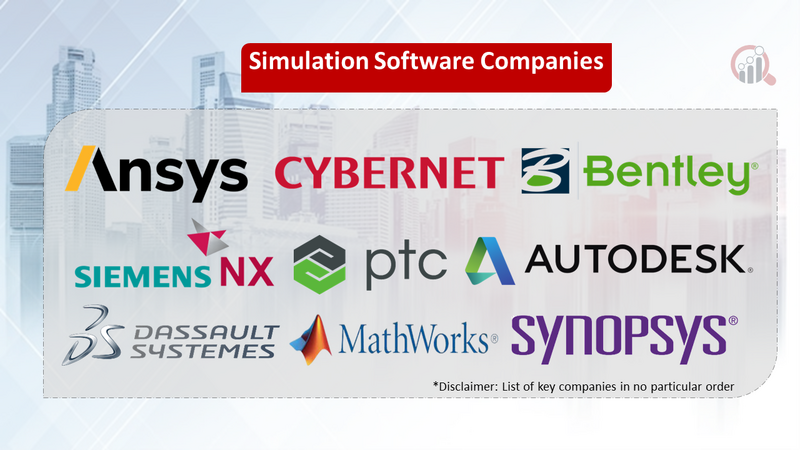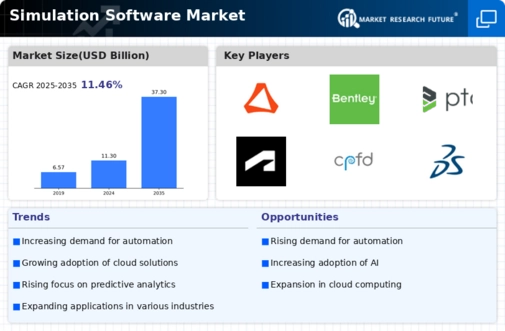Top Industry Leaders in the Simulation Software Market

Competitive Landscape of the Simulation Software Market
The simulation software market is a dynamic and rapidly growing space, driven by increasing demand for virtual testing and optimization across diverse industries. Understanding the competitive landscape of this market is crucial for established players and new entrants alike. This analysis dives into key players, their strategies, market share determining factors, and emerging trends to provide a comprehensive picture.
Key Players:
-
Allair Engineering (U.S.)
-
Bentley Systems (U.S.)
-
Ansys Inc. (U.S.)
-
PTC (U.S.)
-
Siemens PLM Software (U.S.)
-
Autodesk Inc. (U.S.)
-
CPFD Software (U.S.)
-
Cybernet Systems Co. Ltd. (U.S.)
-
Dassault Systemes (France)
-
Design Simulation Technologies
-
Inc. (U.S.)
-
Synopsys Inc. (U.S.)
-
MathWorks Inc. (U.S.)
Strategies Adopted:
-
Product Innovation: Continuous development of new simulation technologies, expanding functionalities, and user-friendly interfaces.
-
Industry Focus: Tailoring solutions to specific industry needs, addressing complex challenges in areas like aerospace, automotive, healthcare, and manufacturing.
-
Cloud-Based Services: Offering software-as-a-service (SaaS) solutions for increased accessibility and affordability.
-
Strategic Partnerships: Collaborating with other technology providers, material suppliers, and research institutions to enhance offerings and reach new markets.
-
Mergers and Acquisitions: Consolidating market share and acquiring new technologies through strategic acquisitions.
Factors for Market Share Analysis:
-
Breadth and Depth of Product Portfolio: Offering a diverse range of simulation tools for various applications and industries.
-
Technological Advancements: Investing in cutting-edge technologies like artificial intelligence, machine learning, and cloud computing to improve accuracy and efficiency.
-
Customer Support and Training: Providing comprehensive training and support services to ensure user success.
-
Pricing Strategies: Balancing cost-effectiveness with advanced features to cater to different customer segments.
-
Brand Reputation and Recognition: Established players hold an advantage due to brand recognition and trust built over time.
New and Emerging Companies:
-
Focus on Specific Niches: Startups are addressing specific industry needs with dedicated solutions, often focusing on cloud-based and user-friendly platforms.
-
Open-Source Software: Open-source simulation software is gaining traction, offering cost-effective alternatives for certain applications.
-
Data-Driven Insights: Integrating data analytics and machine learning into simulation tools to provide deeper insights and predictive capabilities.
Current Investment Trends:
-
Cloud-Based Solutions: Significant investments are being made in cloud-based simulation platforms for increased accessibility and scalability.
-
AI and Machine Learning: Integration of AI and machine learning is transforming simulation by automating tasks, optimizing models, and enabling real-time analysis.
-
Digital Twins: Creating digital twins of physical assets is gaining momentum, allowing for continuous monitoring, optimization, and predictive maintenance.
-
Material Modeling: Advanced material modeling tools are being developed to improve accuracy and predictive capabilities of simulations.
Latest Company Updates:
-
December 15, 2023: Siemens acquires Mentor Graphics: In December 2023, Siemens completed its acquisition of Mentor Graphics, a leading provider of electronic design automation (EDA) software. This move strengthens Siemens' position in the simulation software market, particularly for electronic systems.
-
November 8, 2023: Ansys partners with NVIDIA: In November 2023, Ansys, a leading provider of engineering simulation software, announced a collaboration with NVIDIA to develop AI-powered simulation tools. This partnership aims to leverage NVIDIA's expertise in AI and high-performance computing to accelerate and enhance the simulation process.

